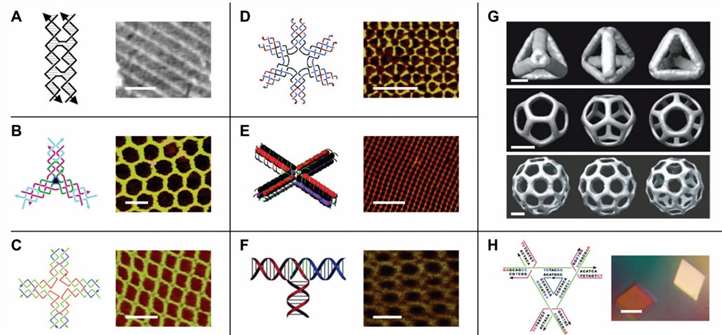Higher-Order Structure Analysis of DNA & RNA Drugs
Creative Proteomics is committed to providing cutting-edge solutions for DNA & RNA higher-order structure analysis. Our expertise lies in DNA & RNA higher-order structure analysis, deciphering the intricate three-dimensional arrangements of nucleic acids.
Introduction of DNA & RNA Drug Higher-Order Structure Analysis
DNA & RNA higher-order structure refers to the three-dimensional arrangement of sequences of DNA & RNA. Unlike the primary structure, which involves the linear sequence of nucleotides, the higher-order structure determines how these sequences fold and interact in three-dimensional space. This spatial arrangement significantly influences their biological functions and interactions with other molecules.
 Fig. 1. DNA tiles and tile-based structures. (Hill A, et al., 2020)
Fig. 1. DNA tiles and tile-based structures. (Hill A, et al., 2020)
Our DNA & RNA Higher Order Structure Analysis Services
Creative Proteomics presents an array of DNA & RNA higher-order structure analysis services, catering to diverse research needs.
Nuclear Magnetic Resonance (NMR) Spectroscopy
NMR spectroscopy is a powerful technique for determining the three-dimensional structure of molecules. It can provide valuable information about the conformational dynamics and interactions of DNA & RNA.
X-ray Crystallography
X-ray crystallography is used to determine the atomic-level structure of crystallized DNA & RNA. It provides high-resolution data on their spatial arrangement, aiding in understanding their functions.
Circular Dichroism (CD) Spectroscopy
CD spectroscopy is commonly employed to study the secondary structure of biomolecules, including DNA & RNA. It can reveal information about their helicity and folding patterns.
Mass Spectrometry
Mass spectrometry can determine the mass and structural features of DNA & RNA. It is particularly useful in analyzing modifications and identifying potential degradation products.
Thermal Melting Analysis
This method measures changes in DNA & RNA structure in response to increasing temperature. It helps identify critical transition points, such as melting temperature (Tm), providing insights into their stability and folding behavior.
Atomic Force Microscopy (AFM)
AFM is another powerful technique used in the analysis of DNA & RNA higher-order structures. As a high-resolution imaging technique, AFM allows researchers to visualize the three-dimensional topography of the sample surface with nanometer-scale resolution.
Process of Higher-Order Structure Analysis
The analysis of DNA & RNA higher-order structure is a meticulous and multi-step process.
Sample Preparation
High-quality samples are crucial for accurate analysis. DNA & RNA must be synthesized or isolated with care to avoid any structural modifications or degradation.
Choice of Analytical Techniques
Researchers must select appropriate techniques based on their specific research questions and the type of information required. NMR spectroscopy and X-ray crystallography are best suited for resolving atomic-level structures, while CD spectroscopy and mass spectrometry provide insights into higher-level structural features.
Data Acquisition
The selected techniques are then employed to obtain data from the DNA & RNA sample. This step requires expertise and precision, as the quality of data directly impacts the accuracy of the final structural model.
Data Analysis and Interpretation
The acquired data is then analyzed using specialized software and compared to known structures or theoretical models. The three-dimensional structure is interpreted, and any potential structural motifs or interactions are identified.
Validation
The proposed structural model is validated using multiple methods, such as re-analyzing the data, performing control experiments, or using complementary techniques. Validating model enhances the confidence in the accuracy of the results.
DNA & RNA Higher Order Structure Analysis Application Fields
The analysis of DNA & RNA higher-order structures finds numerous applications across diverse fields
- Antisense Therapy and RNA Interference.
- Nanotechnology and Biomaterials.
- Viral Research.
- Biomedical Diagnostics.
- Drug Delivery Optimization.
- Gene Regulation Studies.
Creative Proteomics is dedicated to elevating your research through our DNA & RNA higher-order structure analysis services. Let our expertise and innovation fuel your scientific journey toward new discoveries. If you are interested in our services, please contact us for more detailed information.
Reference
- Hill A; Hall J. (2020). High-order structures from nucleic acids for biomedical applications. Materials Chemistry Frontiers.
For research use only, not intended for any clinical use.

 Fig. 1. DNA tiles and tile-based structures. (Hill A, et al., 2020)
Fig. 1. DNA tiles and tile-based structures. (Hill A, et al., 2020)